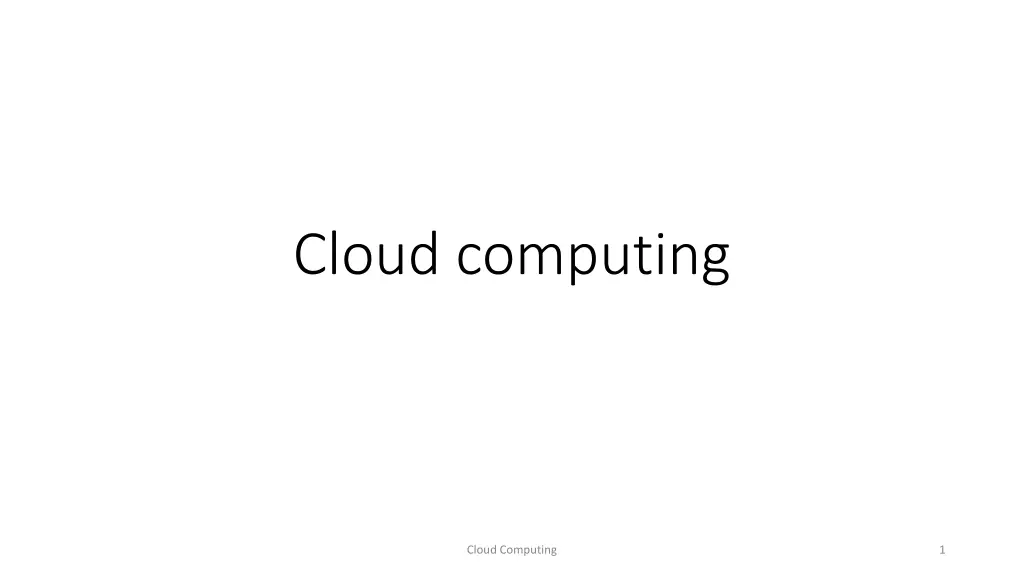
Introduction to Cloud Computing: NIST Definitions and Deployment Models
Explore the NIST definitions of cloud computing, including essential characteristics, service models, deployment models, payment models, and hardware virtualization. Understand the concepts behind private, community, public, and hybrid cloud deployment models. Learn about the shift from traditional hardware purchasing to pay-as-you-go cloud services, with examples from industry leaders like Amazon, Microsoft Azure, and Oracle Cloud.
Download Presentation

Please find below an Image/Link to download the presentation.
The content on the website is provided AS IS for your information and personal use only. It may not be sold, licensed, or shared on other websites without obtaining consent from the author. If you encounter any issues during the download, it is possible that the publisher has removed the file from their server.
You are allowed to download the files provided on this website for personal or commercial use, subject to the condition that they are used lawfully. All files are the property of their respective owners.
The content on the website is provided AS IS for your information and personal use only. It may not be sold, licensed, or shared on other websites without obtaining consent from the author.
E N D
Presentation Transcript
Cloud computing Cloud Computing 1
NIST: Five essential characteristics On-demand self-service Computing capabilities, disks are demanded over the network (no human inter Broad network access Capabilites are available through networks using standard protocols. Used by thick or thin clients Resource pooling Computers are used by different users, depending on demand. Rapid elasticity Capabilities are provisioned and released as needed fast. Measured service Control and optimize services Source: The NIST Definition of Cloud Computing http://csrc.nist.gov/publications/nistpubs/800-145/SP800-145.pdf NIST National Institute of Standards and Technology, USA Cloud Computing 2
NIST: Service Models Software as a Services (SaaS) Consumer uses standard software from the cloud. Example: Google docs, Microsoft Office 365, etc. Platform as a Service (PaaS) Consumer uses standard operating system, network etc. from the cloud Consumer deploys proprietary application software to the cloud. Infrastructure as a Service (IaaS) Consumer uses computing power, disks, network etc. from the cloud Consumer deploys proprietary operations system + application software to the cloud Source: The NIST Definition of Cloud Computing http://csrc.nist.gov/publications/nistpubs/800-145/SP800- 145.pdf Source: https://en.wikipedia.org/wiki/Cloud_co mputing Cloud Computing 3
NIST: Deployment Models Private cloud Cloud is used by a single organization. Owned and managed by the organization or a third party. Community cloud Cloud is used by a community of organizations With shared concerns: Security, etc. Public cloud Cloud is used by the general public Owned and managed by business, academic or government organization Hybrid cloud Combination of 2-3 of the above cloud models Source: The NIST Definition of Cloud Computing http://csrc.nist.gov/publications/nistpubs/800-145/SP800-145.pdf Cloud Computing 4
Payment models Without cloud Buy hardware + software before you need it. You must pay before you earn. With cloud Pay for hardware + software as you need it (if you need it). Pay as you go You must pay as you earn. No upfront infrastructure costs Cloud Computing 5
Hardware virtualization A physical machine (computer) is divided into a number of virtual machines. Virtual machines act like physical machines. Virtual machines can be opened, closed and even moved to another physical machine. Example virtualization software Oracle Virtual Box VMWare Microsoft Hyper-V Cloud Computing 6
Some clouds Amazon 2006 Microsoft Azure 2008 Oracle Cloud 2012 Cloud Computing 7

